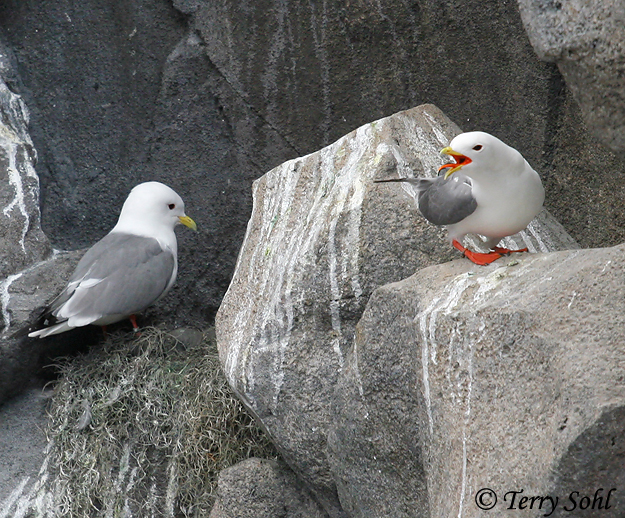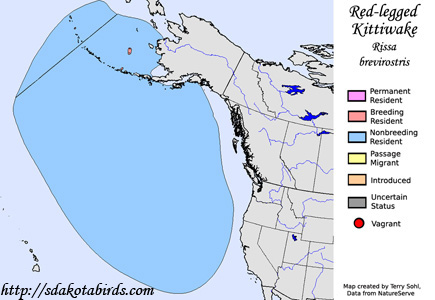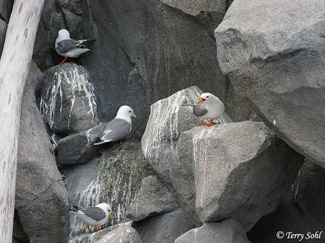| Length: 15 inches | Wingspan: 32 inches | Seasonality: Non-resident in South Dakota |
| ID Keys: Bright red legs, white body, gray upperwings, black wing tips, gray back | ||
 The
Red-legged Kittiwake is a beautiful small gull species that most will never
see in the wild. They nest on a few rugged islands in the Bering Sea,
and in winter are dispersed widely over the North Pacific. They are
closely related to the
Black-legged Kittiwake with behaviors that are largely similar, but the
Red-legged Kittiwake is much rarer.
The
Red-legged Kittiwake is a beautiful small gull species that most will never
see in the wild. They nest on a few rugged islands in the Bering Sea,
and in winter are dispersed widely over the North Pacific. They are
closely related to the
Black-legged Kittiwake with behaviors that are largely similar, but the
Red-legged Kittiwake is much rarer.
Habitat: Found on isolated islands with rocky cliffs during the breeding season. At other times during the year, found over the open ocean, typically very far from land.
Diet: Feeds on fish, small crustaceans, and squid.
Behavior: Forages by flying over the ocean's surface, flying down to skim food items at the surface, or making shallow dives to grab items below the surface. Will feed both day and night.
Nesting: The nest of a Red-legged Kittiwake is a cup built of mud, seaweed, and grasses, built on a cliff ledge. The female lays one or two eggs, and both parents help to incubate them. Upon hatching, both parents tend to them and feed them.
Song: Has a high squealing call typically heard on breeding colonies. When away from nesting grounds, they are typically silent.
Migration: Nests on a few isolated islands in the Bering Sea. At other seasons, found in much of the North Pacific, often far out to sea, and as far north as the edge of the pack ice in the Bering Sea.
Interactive eBird Map: Click here to access an interactive eBird map of Red-legged Kittiwake sightings
Similar Species: Black-legged Kittiwake
Conservation Status: Populations decreased significantly in the 20th century, but may now have stabilized at a sustainable level. The IUCN lists the Red-legged Kittiwake as a "Vulnerable" species.
Further Information: 1) Alaska Seabird Information Series - Red-legged Kittiwake
2) USGS Bird InfoCenter - Red-legged Kittiwake
3) Audubon's Field Guide - Red-legged Kittiwake
Photo Information: Photo taken in June 2006 - Alaska SeaLife Center in Seward, Alaska - Terry Sohl
| Click below for a higher-resolution map |
 |
| South Dakota Status: Non-resident in South Dakota |
Additional Red-legged Kittiwake Photos
Click for a higher-resolution version of these photos

